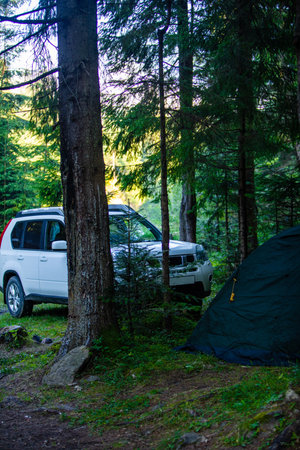1. The Importance of Emergency Preparedness in the Outdoors
When youre out camping—especially in remote or unfamiliar locations—being prepared for emergencies isnt just a good idea, its absolutely essential. Unlike urban settings where help might be minutes away, the great outdoors often means limited cell service, long distances from emergency services, and unpredictable weather or wildlife encounters. That’s why having a solid emergency plan can make all the difference between a minor hiccup and a serious situation.
Why Being Prepared Matters
Nature is beautiful, but it can also be unforgiving. From sudden storms to injuries on the trail, emergencies can happen fast and without warning. Having the right gear, including light sources like flashlights and lanterns, ensures that you can navigate safely and respond quickly when things go wrong.
Common Emergency Scenarios While Camping
Here are some typical emergencies campers might face—and how being prepared helps:
| Emergency Scenario | Potential Risks | How Preparedness Helps |
|---|---|---|
| Getting Lost After Dark | Poor visibility, increased chance of injury or panic | A flashlight or lantern helps you see trails and landmarks clearly |
| Sudden Weather Changes | Hypothermia, wet gear, difficult navigation | Preparedness includes checking forecasts and packing emergency blankets & lighting |
| Injury While Hiking or Setting Up Camp | Limited mobility, need for first aid in low light | A well-lit area makes it easier to administer first aid and signal for help if needed |
| Wildlife Encounters at Night | Panic, danger from animals attracted to food or camp | Light can deter animals and help you stay aware of surroundings |
Being Proactive vs. Reactive
The key to outdoor safety is thinking ahead. Packing essentials like a reliable flashlight or lantern isn’t just about convenience—it’s about making sure you have what you need when the unexpected happens. A little foresight goes a long way toward keeping your adventure safe and enjoyable.
Remember:
You don’t need to be a survival expert to camp safely—you just need to be ready for what nature might throw your way.
2. Power Outages and Unpredictable Weather Conditions
When youre out camping, especially in remote areas, youre completely at the mercy of Mother Nature. One minute the sky is clear, and the next, a sudden thunderstorm rolls in. These unexpected weather events can knock down trees, damage campsites, and most importantly—kill your power sources. A fallen tree might take down nearby power lines if you’re camping near a powered site, or strong winds could ruin your solar panels or cause battery-powered devices to fail.
Even without extreme weather, simple things like forgetting to recharge batteries or not packing spares can leave you without light when you need it most. And let’s be honest—nobody wants to stumble around in the dark trying to find their way to the bathroom or locate essential gear during an emergency.
Common Causes of Blackouts While Camping
| Cause | Impact | Why Lighting Matters |
|---|---|---|
| Sudden Storms | Rain and wind can damage gear and block sunlight for solar chargers | A reliable flashlight or lantern ensures you stay safe and mobile |
| Fallen Trees | Trees may knock out campsite power or block paths | You need visibility to assess damage or navigate safely |
| Battery Failures | Batteries die faster in cold temps or with overuse | Backup lighting options keep you from being left in the dark |
The Importance of Reliable Gear
This unpredictability is exactly why dependable lighting gear is a must-have in every camper’s pack. Flashlights and lanterns that are waterproof, shock-resistant, and have long battery life can make all the difference when things go south. Look for models that offer multiple power sources—like solar, rechargeable batteries, or hand-crank options—to cover your bases. And always bring backups!
Quick Tips for Staying Prepared:
- Pack multiple light sources: A mix of headlamps, flashlights, and lanterns gives you flexibility.
- Check batteries before leaving: Fully charge everything and bring extras.
- Select weather-resistant gear: Choose lights rated for rain, snow, and rough handling.
The outdoors are beautiful—but they don’t come with a light switch. Being ready for anything means having the right tools to see clearly no matter what happens.
![]()
3. Flashlights vs. Lanterns: When and Why You Need Both
When youre out camping, being prepared for emergencies means having the right kind of lighting gear. Both flashlights and lanterns serve important but different purposes, especially in unpredictable situations like power outages, sudden weather changes, or navigating unfamiliar terrain after dark. Knowing when to use each can make a big difference in your safety and comfort at the campsite.
Mobility and Directional Lighting: Flashlights
Flashlights are perfect for mobility. Whether youre hiking back to camp after dark, searching through your gear, or heading to the restroom at night, a flashlight gives you focused, directional light that goes exactly where you need it. Theyre lightweight, easy to pack, and ideal for one-person use.
Benefits of Flashlights:
- Directional Beam: Perfect for seeing far ahead or into tight spaces.
- Portable: Easy to carry in hand or mount on a head strap.
- Quick Access: Great for urgent tasks like checking noises or walking in darkness.
Ambient Area Illumination: Lanterns
Lanterns provide a wide spread of light thats ideal for lighting up larger areas like your tent, picnic table, or cooking space. They’re designed to be stationary and work well when youre not moving around much but still need good visibility all around you.
Benefits of Lanterns:
- 360-Degree Lighting: Illuminates an entire area without needing to be held.
- Hands-Free: Can be placed on a table or hung inside a tent.
- Great for Groups: Ideal for shared spaces or group activities at night.
Flashlight vs. Lantern: Quick Comparison
| Feature | Flashlight | Lantern |
|---|---|---|
| Light Direction | Narrow & Focused | Wide & Diffused (360°) |
| Best Use Case | Walking, searching, emergencies on-the-go | Campsite lighting, tents, meals, group activities |
| Portability | Highly portable (handheld or head-mounted) | Larger, usually stationary |
| Battery Life | Longer with LED models; varies by brightness setting | Tends to use more power over time due to wider illumination |
The Bottom Line: Carry Both
If you’re serious about being ready for anything while camping, don’t choose between a flashlight and a lantern—bring both. A flashlight helps you move safely through the dark when every second counts. A lantern keeps your basecamp lit so you can cook dinner, play cards with friends, or find your gear without fumbling in the dark. Having both ensures youre covered no matter what kind of emergency pops up during your outdoor adventure.
4. Choosing the Right Gear for Emergency Lighting
When youre out camping, especially in remote or unfamiliar areas, having reliable emergency lighting isnt just a nice-to-have—its essential. Whether youre dealing with a power outage at your campsite or navigating through dark terrain, choosing the right flashlight or lantern can make all the difference. Heres what to look for when picking high-quality emergency lighting gear.
Battery Life
One of the most important features to consider is battery life. You want lights that will last through the night or even multiple nights without needing a recharge or battery replacement. Look for models that offer long runtime on low and medium settings—it’s not always about brightness, but how long it lasts when you need it most.
Water Resistance
Weather can be unpredictable, and your gear should be ready for anything. A good emergency flashlight or lantern should have at least an IPX4 water resistance rating, meaning it can handle splashes from any direction. If you’re expecting heavy rain or wet conditions, go for higher ratings like IPX6 or IPX7.
Built-in Charging Options
Modern camping lights often come with built-in rechargeable batteries and even USB ports to charge other devices like phones. Some models include solar panels or hand-crank options—these are great for extended trips where access to electricity is limited.
Durability
Your lighting gear should be tough enough to withstand drops, knocks, and rough handling. Look for products made with rugged materials like aluminum alloy or impact-resistant plastic. If youre going into rugged terrain, this feature becomes even more critical.
Quick Comparison Table
| Feature | Why It Matters | What to Look For |
|---|---|---|
| Battery Life | Ensures light lasts through emergencies | 8+ hours on low/medium setting |
| Water Resistance | Protects against weather conditions | Minimum IPX4; ideal is IPX6/IPX7 |
| Charging Options | Keeps light usable over longer trips | USB recharge, solar panel, hand-crank |
| Durability | Withstands rough outdoor use | Shockproof design, strong casing material |
Pro Tip:
If you’re unsure which light to choose, consider carrying both a headlamp and a lantern. Headlamps keep your hands free while walking or setting up camp in the dark, and lanterns are perfect for lighting up larger areas like tents or picnic tables.
Your safety during a camping trip starts with being prepared—and that means picking the right tools before you hit the trail.
5. Best Practices for Keeping Your Lighting Gear Ready
When youre out in the wild, the last thing you want is to reach for your flashlight or lantern and find it dead—or worse, missing. Being prepared means keeping your lighting gear in top shape and easy to access at all times. Here are some practical tips to help make sure your flashlights and lanterns are always ready when you need them most.
Routine Checks Are Key
Just like you’d check your car before a road trip, give your lighting gear a quick once-over before every camping trip. Test each flashlight and lantern to make sure it powers on and produces strong light. Check for signs of corrosion or damage, especially around battery compartments.
Maintenance Checklist
| Task | How Often |
|---|---|
| Test lights for functionality | Before each trip |
| Inspect batteries for leakage or corrosion | Monthly or pre-trip |
| Clean lenses and light surfaces | As needed |
| Check for cracked casings or buttons | Every few months |
Know Your Power Source
Flashlights and lanterns come with different power setups—some use disposable batteries, others are rechargeable. Make sure you know how yours work and bring along what’s needed to keep them powered up.
Packing Extra Power
- If your device uses AA or AAA batteries, pack extras in a waterproof container.
- For rechargeable models, bring a power bank or solar charger.
- Label chargers or cables so you know which device they belong to.
- Avoid mixing old and new batteries—it can shorten overall battery life.
Keep Lighting Accessible at All Times
You never know when an emergency might hit—maybe its a sudden storm or an unexpected late-night bathroom run. Keep at least one flashlight within arms reach at night, ideally near your sleeping bag or inside your tent pocket. Hang lanterns where they’re easy to grab quickly if needed.
Smart Storage Ideas
- Tent pockets: Store a small flashlight here for quick nighttime access.
- Campsite table bin: Keep all lighting gear organized in one weatherproof box.
- Backpack side pocket: Place a headlamp where it’s easy to reach on the go.
- Car emergency kit: Include backup lighting just in case you return late from a hike.
Stay One Step Ahead
The key to emergency preparedness while camping isn’t just having the right gear—it’s making sure that gear works when you need it most. With regular checks, smart storage, and extra power sources on hand, you’ll be ready for anything the wilderness throws your way—even in the dark.


